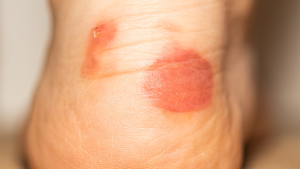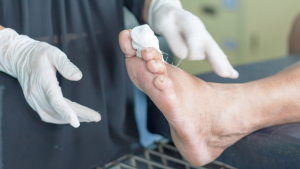If you have diabetes, even a small sore on your foot can turn serious fast. An early stage diabetic foot ulcer—especially on the heel or toe—might seem minor at first, but without proper care, it can quickly worsen and lead to infection or even amputation. That’s why early intervention and expert wound care are critical.
In Columbus, GA, patients have access to advanced diabetic foot ulcer treatment designed to stop ulcers before they progress. With the right care plan, many foot wounds can heal fully—restoring mobility and preventing long-term complications.
In this article, we’ll explain how to recognize the signs of an early stage diabetic foot ulcer, explore treatment options, and answer the most common questions about wound care for diabetic foot ulcers. Don’t wait until a small issue becomes a big one—learn how to protect your feet and your health today.
Table of Contents
Why Diabetic Foot Ulcers Happen—and How to Catch Them Early
 A diabetic foot ulcer is an open sore or wound that typically forms on the bottom of the foot, toe, or heel. These ulcers happen because diabetes can reduce blood flow and damage the nerves in your feet—a condition known as peripheral neuropathy. When this happens, you may not feel pain or notice small injuries right away.
A diabetic foot ulcer is an open sore or wound that typically forms on the bottom of the foot, toe, or heel. These ulcers happen because diabetes can reduce blood flow and damage the nerves in your feet—a condition known as peripheral neuropathy. When this happens, you may not feel pain or notice small injuries right away.
Without proper sensation, something as simple as a blister, tight shoe, or small cut can turn into an early stage diabetic foot ulcer. If left untreated, that minor wound can deepen and become infected, increasing your risk of hospitalization or amputation.
The good news? You can often prevent serious complications by catching ulcers early. Signs of an early stage diabetic foot ulcer on the toe or heel include:
-
Redness or irritation
-
Skin that feels warmer than usual
-
Drainage or discharge on your socks
-
A shallow sore that doesn’t seem to heal
At this stage, wound care for diabetic foot ulcers can be highly effective. That’s why it’s important to check your feet daily and schedule regular visits with a podiatrist—especially if you’ve had ulcers before.
Recognizing the Early Signs
 Spotting an early stage diabetic foot ulcer can make all the difference in your recovery. These ulcers often begin silently, especially if you have nerve damage from diabetes. That’s why even small changes in your feet should never be ignored.
Spotting an early stage diabetic foot ulcer can make all the difference in your recovery. These ulcers often begin silently, especially if you have nerve damage from diabetes. That’s why even small changes in your feet should never be ignored.
Look for these early warning signs:
-
A reddened area on the foot, toe, or heel
-
A shallow sore or blister that doesn’t heal
-
Drainage or blood stains on your socks
-
Swelling, warmth, or skin discoloration
-
A small wound with no pain (due to nerve damage)
An early stage diabetic foot ulcer on the toe or heel may seem minor, but it can quickly worsen if left untreated. Daily foot checks are essential, especially for those with poor circulation or a history of ulcers.
Why Prompt Wound Care Matters
When it comes to an early stage diabetic foot ulcer, time is critical. What starts as a small sore—especially on the toe or heel—can quickly develop into a serious infection if not treated. That’s why getting prompt, professional wound care for diabetic foot ulcers is essential.
Without the right care, diabetic ulcers can worsen and lead to:
-
Tissue damage and skin breakdown
-
Deep infections reaching bone or tendons
-
Long healing times and limited mobility
-
In severe cases, hospitalization or amputation
Early diabetic foot ulcer treatment focuses on cleaning the wound, reducing pressure on the area (called offloading), and applying specialized dressings. In some cases, a podiatrist may also recommend antibiotics or advanced wound care technologies to speed up healing.
If you notice even a minor wound, don’t wait—getting early treatment can protect your foot and your overall health.
Where to Get Diabetic Foot Ulcer Care in Columbus, GA
 If you’re dealing with an early stage diabetic foot ulcer, expert care is available at Ankle & Foot Centers of America. The Columbus team provides advanced, patient-centered treatment specifically designed for diabetic foot wounds. With a strong focus on early intervention, effective wound healing, and long-term prevention, patients receive the comprehensive care needed to stay active and avoid complications.
If you’re dealing with an early stage diabetic foot ulcer, expert care is available at Ankle & Foot Centers of America. The Columbus team provides advanced, patient-centered treatment specifically designed for diabetic foot wounds. With a strong focus on early intervention, effective wound healing, and long-term prevention, patients receive the comprehensive care needed to stay active and avoid complications.
Services include:
-
Preventive foot exams for high-risk diabetic patients
-
Advanced wound care techniques for early and chronic ulcers
-
Custom orthotics to reduce pressure and support healing
-
Surgical treatment when necessary for non-healing or severe ulcers

Conclusion: Don’t Wait to Treat a Diabetic Foot Ulcer
Addressing a diabetic foot ulcer in its early stage is critical. Fast, effective treatment can prevent infection, speed recovery, and reduce the risk of complications. If you’ve noticed a sore or wound that isn’t healing, or you’re at risk due to diabetes, don’t wait to seek help.
The experienced team at Ankle & Foot Centers of America is here to guide you every step of the way. Schedule your appointment today and take the first step toward expert diabetic foot care and long-term relief.






